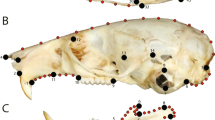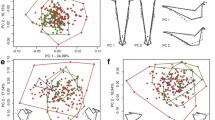Abstract
South American cervids have a relatively recent evolutionary history in the Neotropics. Present taxonomical richness includes six genera and 17 species grouped in at least two clades, Blastocerina and Odocoileina. With few exceptions, functional morphology or ecomorphological approaches have not been rigorously applied to the masticatory apparatus of Neotropical deer. In order to understand the relationship between craniomandibular integration and feeding behavior, we used geometric morphometric methods (3D landmarks) to quantify the strength and significance of the correlation between morphology and feeding behavior. Two blocks Partial Least Squares analyses, angular comparison, regression analysis, and independent contrast were performed to explore the patterns of covariation between cranial and mandibular shape and size, and between them and continuous dietary characters. The main variation in shape is related to a gradient from a brachycephalic cranium with a robust mandible in small deer to a dolicocephalic cranium with a gracile mandible in large deer. These shape changes seem to be modeled by a complex interplay of allometric trends and biomechanically significant features related to the proportions of dietary monocotyledon, fruit, or dicotyledonous plant material. We find remarkable convergences in the brocket deer ecomorphotype in the two clades of Neotropical cervids, as well as similar craniomandibular traits between marsh and pampas deer with African mixed feeder bovids related to monocotyledon consumption. These findings lead us to share Radinsky’s interest in convergences in the masticatory apparatus of herbivorous mammals.




Similar content being viewed by others
References
Arnold C, Matthews LJ, Nunn CL (2010) The 10kTrees website: a new online resource for primate phylogeny. Evol Anthropol 19:114–118
Barčiová L (2009) Advances in insectivore and rodent systematics due to geometric morphometrics. Mammal Rev 39:80–91
Cardini A, Elton S (2008) Does the skull carry a phylogenetic signal? Evolution and modularity in the guenons. Biol J Linnean Soc 93:813–834
Cardini A, Polly PD (2013) Larger mammals have longer faces because of size-related constraints on skull form. Nat Commun 4:2458
Cassini GH (2013) Skull geometric morphometrics and paleoecology of Santacrucian (late early Miocene; Patagonia) native ungulates (Astrapotheria, Litopterna, and Notoungulata). Ameghiniana 50:193–216
Cassini GH, Flores DA, Vizcaíno SF (2015) Postnatal ontogenetic scaling of pampas deer (Ozotoceros bezoarticus celer: Cervidae) cranial morphology. Mammalia 79:69–79
Cassini GH, Muñoz NA, Merino ML (2016) Evolutionary history of South American Artiodactyla. In: Agnolin FL, Lio GL, Brissón Egli F, Chimento NR, Novas FE (eds) Historia evolutiva y paleobiogeográfica de los vertebrados de américa del sur. Contribuciones del MACN:6, Buenos Aires, pp 673–689
Cassini GH, Vizcaíno SF, Bargo MS (2012) Body mass estimation in early Miocene native South American ungulates: a predictive equation based on 3D landmarks. J Zool 287:53–64
Clauss M, Kaiser T, Hummel J (2008) The morphophysiological adaptations of browsing and grazing mammals. In: Gordon IJ, Prins HHT (eds) The Ecology of Browsing and Grazing. Springer-Verlag, Berlin, pp 47–88
Delupi LH, Bianchini JJ (1995) Análisis morfológico comparado de los caracteres craneo-faciales en el ciervo de las pampas Odocoileus bezoarticus y formas relacionadas. Physis 50:23–36
Drake AG, Klingenberg CP (2008) The pace of morphological change: historical transformation of skull shape in St Bernard dogs. Proc R Soc Lond B Bio 275:71–76
Dryden IL, Mardia KV (1998) Statistical Shape Analysis. John Wiley & Sons, Chichester
Duarte JMB, González S (2010) Neotropical Cervidology. Biology and Medicine of Latin American Deer. FUNEP & IUCN, Jaboticabal
Duarte JMB, González S, Maldonado JE (2008) The surprising evolutionary history of South American deer. Mol Phylogenet Evol 49:17–22
Fox J, Weisberg S (2011) An R Companion to Applied Regression. Sage, Los Angeles
Fraser D, Rybczynski N (2014) Complexity of ruminant masticatory evolution. J Morphol 275:1093–1102
Fraser D, Theodor JM (2011) Anterior dentary shape as an indicator of diet in ruminant artiodactyls. J Vertebr Paleontol 31:1366–1375
González S, Álvarez-Valin F, Maldonado JE (2002) Morphometric differentiation of endangered pampas deer (Ozotoceros bezoarticus), with description of new subspecies from Uruguay. J Morphol 84:1127–1140
González S, Bonfim Mantellatto AM, Duarte JMB (2018) Craniometrical differentiation of gray brocket deer species from Brazil. Rev Mus Arg Cien Nat ns 20:179–193
Greaves WS (1991) The orientation of the force of the jaw muscles and the length of the mandible in mammals. Zool J Linnean Soc 102:367–374
Greaves WS (2012) The Mammalian Jaw: A Mechanical Analysis. Cambridge University Press, Cambridge
Gutiérrez EE, Helgen KM, McDonough MM, Bauer F, Hawkins MTR, Escobedo-Morales LA, Patterson BD, Maldonado JE (2017) A gene-tree test of the traditional taxonomy of American deer: the importance of voucher specimens, geographic data, and dense sampling. ZooKeys 697:87–131
Heckeberg NS, Erpenbeck D, Wörheide G, Rössner GE (2016) Systematic relationships of five newly sequenced cervid species. PeerJ 4:e2307
Herring SW, Herring SE (1974) The superficial masseter and gape in mammals. Am Nat 108:561–576
Janis CM (1995) Correlations between craniodental morphology and feeding behavior in ungulates: reciprocal illumination between living and fossil taxa. In: Thomason JJ (ed) Functional Morphology in Vertebrate Paleontology. Cambridge University Press, Cambridge, pp 76–98
Janis CM (2000) Patterns in the evolution of herbivory in large terrestrial mammals: the Paleogene of North America. In: Sues HD, Labanderia C (eds) Evolution of Herbivory in Terrestrial Vertebrates. Cambridge University Press, Cambridge, pp 168–222
Janis CM (2007) Artiodactyl paleoecology and evolutionary trends. In: Prothero DR, Foss SE (eds) The Evolution of Artiodactyls. John Hopkins University Press, Baltimore, pp 292–302
Janis CM, Theodor JM (2014) Cranial and postcranial morphological data in ruminant phylogenetics. Zitteliana 32:15–31
Kay RF (2019) Leonard B. Radinsky (1937-1985), radical biologist. J Mammal Evol https://doi.org/10.1007/s10914-019-09479-4
Klingenberg CP (2009) Morphometric integration and modularity in configurations of landmarks: tools for evaluating a priori hypotheses. Evol Dev 11:405–421
Klingenberg CP (2011) MorphoJ: an integrated software package for geometric morphometrics. Mol Ecol Resour 11:353–357
Klingenberg CP (2013) Cranial integration and modularity: insights into evolution and development from morphometric data. Hystrix 24:43–58
Klingenberg CP, Marugán-Lobón J (2013) Evolutionary covariation in geometric morphometric data: analyzing integration, modularity, and allometry in a phylogenetic context. Syst Biol 62:591–610
Maddison WP (1991) Squared-change parsimony reconstructions of ancestral states for continuous-valued characters on a phylogenetic tree. Syst Biol 40:304–314
Mattioli S (2011) Family Cervidae, deer. In: Wilson DE, Mittermeier RA (eds) Handbook of the Mammals of the World – Volume 2. Hoofed Mammals. Lynx Edicions, Barcelona, pp 350-443
Mendoza M, Palmqvist P (2008) Hypsodonty in ungulates: an adaptation for grass consumption or for foraging in open habitat? J Zool 274:134–142
Merino ML, Rossi RV (2010) Origin, systematics and morphological radiation. In: Duarte JMB, González S (eds) Neotropical Cervidology. Biology and Medicine of Latin American Deer. FUNEP & IUCN, Jaboticabal, pp 2–11
Merino ML, Milne N, Vizcaíno SF (2005) A cranial morphometric study of deer (Mammalia, Cervidae) from Argentina using three-dimensional landmarks. Acta Theriol 50:91–108
Olsen AM (2017) Feeding ecology is the primary driver of beak shape diversification in waterfowl. Funct Ecol 31:1985–1995
R Core Team (2018) R: A Language and Environment for Statistical Computing. R Foundation for Statistical Computing, Vienna
Radinsky LB (1969) The early evolution of the Perissodactyla. Evolution 23:308–328
Radinsky LB (1985) Patterns in the evolution of ungulate jaw shape. Am Zool 25:303–314
Radinsky LB (1987) The Evolution of Vertebrate Design. University of Chicago Press, Chicago
Reddy DP, Kim J, Raaum R (2007) Resample.exe: http://pages.nycep.org/nmg/programs.html
Rohlf FJ (1990) Rotational fit (Procrustes) methods. In: Rohlf FJ, Bookstein FL (eds) Proocedings of the Michigan Morphometrics Workshop. Univ Michigan Mus Zool Spec Publ 2: 227–236
Schlager S (2017) Morpho and Rvcg - shape analysis in R. In: Zheng G, Li S, Szekely G (eds) Statistical Shape and Deformation Analysis. Academic Press, London, pp 217–256
Spencer LM (1995) Morphological correlates of dietary resource partitioning in the African Bovidae. J Mammal 76:448–471
Vizcaíno SF, Bargo MS (2019) Views on the form-function correlation and biological design. J Mammal Evol https://doi.org/10.1007/s10914-019-09487-4
Vizcaíno SF, Bargo MS, Cassini GH, Toledo N (2016) Forma y Función en Paleobiología de Vertebrados. Editorial de la Universidad Nacional de La Plata (EDULP), La Plata
Warton DI, Hui FKC (2011) The arcsine is asinine: the analysis of proportions in ecology. Ecology 92:3–10
Zurano JP, Magalhães FM, Asato AE, Silva G, Bidau CJ, Mesquita DO, Costa GC (2019) Cetartiodactyla: updating a time-calibrated molecular phylogeny. Mol Phylogenet Evol 133:256–262
Acknowledgments
We thank N. Simmons (AMNH), H. Pastore and E. Ramilo (APN-DRP), M. Beade (CDT), S. Bogan (CFA), R. Barquez (CML), Pablo Teta (MACN), D. Verzi and I. Olivares (MLP), A. Pautaso (MFA), M. De Vivo (MUZSP), J.M. Barbanti Duarte (NUPECCE), and K. Zyskowski (YPM) for access to mammalogy collections; the organizers of the XXXI Jornadas Argentinas de Mastozoologia, La Rioja, Argentina, A. Chemisquy and F. Prevosti for allowing us organizing the symposium: “El paradigma de correlación forma-función en mastozoología: un tributo a Leonard Radinsky (1937–1985)”; S. Vizcaíno and R. Fariña for having introduced us to Radinsky’s delightful text as students; S. Bargo, N. Milne, N. Muñoz, and M. Merino for fruitful discussions on form-function, geometric morphometrics, and deer that inspired this manuscript; G. De Iuliis and the reviewers whose comments greatly enhanced this manuscript. This is a contribution to the projects Universidad Nacional de Luján CDDCB 650/14 and 016/19; and Agencia Nacional Promoción Científica y Tecnológica PICT-2015-2389.
Author information
Authors and Affiliations
Corresponding author
Rights and permissions
About this article
Cite this article
Cassini, G.H., Toledo, N. An Ecomorphological Approach to Craniomandibular Integration in Neotropical Deer. J Mammal Evol 28, 111–123 (2021). https://doi.org/10.1007/s10914-020-09499-5
Published:
Issue Date:
DOI: https://doi.org/10.1007/s10914-020-09499-5




